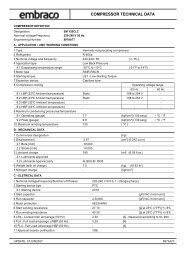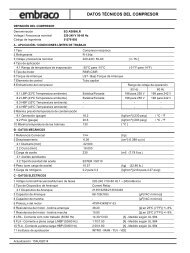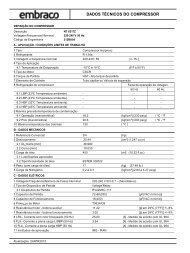Compressor Handbook - Embraco
Compressor Handbook - Embraco
Compressor Handbook - Embraco
You also want an ePaper? Increase the reach of your titles
YUMPU automatically turns print PDFs into web optimized ePapers that Google loves.
6.11 VACUUM OPERATIONS<br />
COMPRESSORS<br />
HANDBOOK<br />
Chapter<br />
INFORMATION ABOUT CORRECT COMPRESSOR INSTALLATION<br />
It is fundamental to perform a proper evacuation of the refrigeration system to ensure proper running<br />
of the refrigerating machine, and to preserve the life of the compressor. A proper evacuation<br />
process assures that the air and moisture contents are below the allowed limits.<br />
The introduction of new refrigerants require the use of new polyester oils with characteristics of<br />
high hygroscopicity which require the greatest care in system evacuation. There are various<br />
methods to evacuate a refrigeration system: one-side (low pressure side), two-side (low and high<br />
pressure sides), at different times, with phases of refrigerant pre-charge, etc. We must aim to<br />
reach a vacuum value (measured at its stabilization on both the low and high pressure sides), better<br />
than 0.14 mbar (100 µHg), and the maximum level of non-condensable must not exceed<br />
0.3%.<br />
PLEASE NOTE: To avoid irreparable damages to the compressor, never start it under vacuum (without<br />
refrigerant charge).<br />
6.12 REFRIGERANT CHARGE<br />
After the vacuum operation, the system must be charged with the refrigerant type indicated on<br />
the compressor nameplate or one of the alternate allowed types, in the pre-determined quantity.<br />
For a correct charge we suggest, after carrying out the vacuum, to pump part of the refrigerant<br />
into the compressor to “break” the vacuum; then start the compressor to draw the remaining part<br />
of the charge.<br />
In the small refrigerating systems utilizing few grams of charge, the refrigerant is usually<br />
pumped into the compressor through the service tube. In this case you must wait 5 to 10 minutes<br />
(time depending on the refrigerant quantity and on the ambient temperature), before starting the<br />
compressor. This to allow partial refrigerant evaporation and to avoid the suction of liquid refrigerant<br />
into the compressor cylinder.<br />
PLEASE NOTE: The refrigerant mixtures must be charged in the system exclusively at liquid state.<br />
Table 37 Maximum Refrigerant Charge<br />
SERIES EM - NE T NJ - NT<br />
REFRGERANT<br />
CHARGE (g)<br />
350 500 800<br />
In case the refrigerant charge should exceed the max values allowed for the compressor, take care<br />
that the circuit is equipped with liquid receiver, and, for larger systems, an oil heater in the compressor<br />
housing to avoid mixing of refrigerant in the oil, foaming with subsequent liquid suction<br />
and pumping. If it becomes necessary for a technician to recharge the system in the field, he<br />
should first remove all of the remaining original charge, and then recharge the system in accordance<br />
with the refrigerant quantity indicated on the data plate.<br />
PLEASE NOTE: The use of the compressor outside the intended working range cannot make use of the<br />
warranty.<br />
Doc. Code Emission Revision Date Page<br />
MP01E 2000-04 0 20-02 76 - 98

















